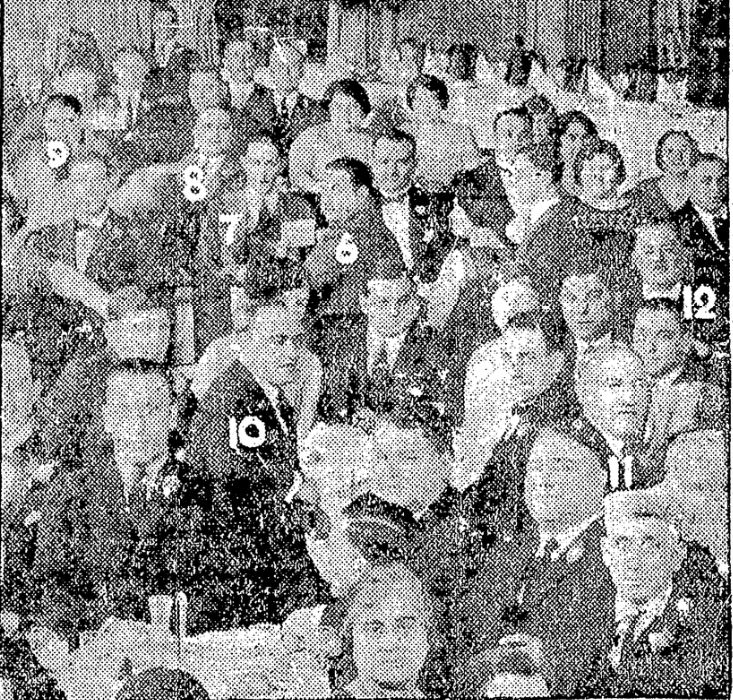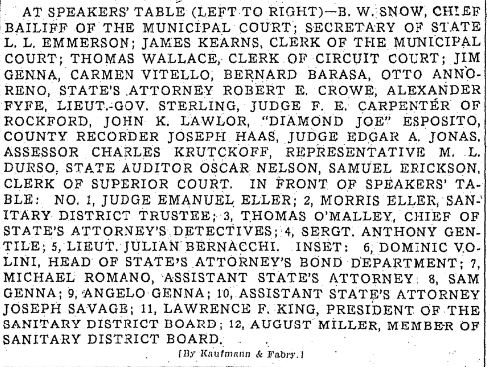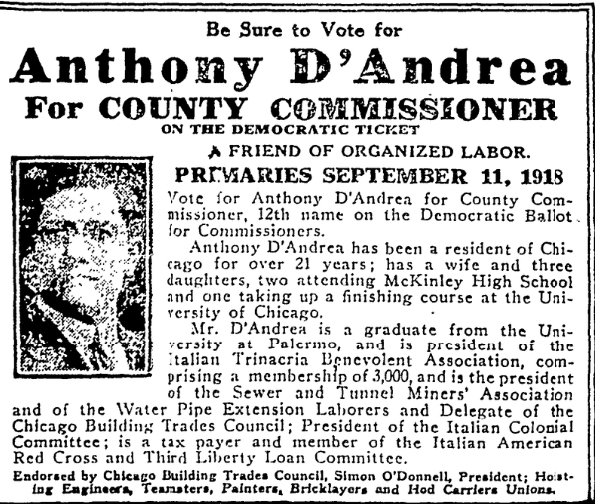PolackTony wrote: ↑Wed Sep 28, 2022 8:22 am
On the subject of Constantino Vitello, who was IANU Supreme President. He was also a witness to Tony Lombardo's 1926 naturalization. The other witness was Vincenzo "Vincent Ernest" Ferrara, a banker from Castelbunoi, Palermo, who over the following decades held the positions of Supreme President (late 1930s) and Secretary-Treasurer of the IANU.
To continue with the theme of Constantino Vitello. Family trees have his parents as Gaetano Vitello and Filomena Tirone. That this genealogy is correct is strongly supported by the fact that Constantino's eldest son and daughter were named, respectively, Gaetano and Filomena. Constantino arrived in Chicago in 1907 and was naturalized there in 1916 (one of his witnesses was a Ferrara). His wife was Angelina Licata of Racalmuto, which is practically a frazione of Grotte. Grotte borders, on one side, Aragona, with obvious connections to the Rockford mafia, and then on the other side, Canicatti, which we have already seen was strongly connected to LoVerde in the major 1930 bootlegging operation that included the Argentos and Carlisis. As we've seen previously, LoVerde, Nicola Diana, Cipriano Argento, and the Carlisis were all residing in Cicero in 1930. So was Constantino Vitello (on S 58th Ct). Prior to this, Vitello had lived on the Northside of the City; interesting that a number of Sicilians from the Northside all seemed to have relocated to Cicero (which was Capone Ground Zero and also home to numerous alcohol stills) around 1930. Indeed, one of the co-conspirators busted in that big 1930 case was named in the papers as a Josaliscento [sic] Vitello.
In 1927 and 1928, Vitello was named in the papers as the Vice President of the IANU under then-Supreme President, former judge and famed attorney Bernard P "Barney" Barasa (Vincent E Ferrara was Treasurer). In 1926, the Chicago Daily News published an expose piece on a huge fundraising banquet that the Genna brothers held in 1924 for the re-election of Cook County States Attorney Robert Crowe (a close ally of flamboyantly corrupt Chicago Mayor Big Bill Thompson). With Tony Genna responsible for promoting the event and selling tickets, master of ceremonies Jim Genna presided with Crowe as guest of honor. The News reported that numerous important public officials and members of LE attended and partied with mafiosi incuding the Genna brothers, Diamond Joe Esposito, Genna in-law Henry Spingola, and Giovanni Scalise. Also present at the speakers' table with the Gennas and Esposito were Barney Barasa and "Carmen Vitello". As there seem to be no records that would match a Carmine/Carmen Vitello, this was clearly Constantino Vitello (see below).
In 1927, Constantino and his son, Gaetano "Thomas" Vitello", then 18-years-old, were involved in a shootout with undercover detectives in front of Constantino's jewelry store on Oak St in Little Sicily. Thomas Vitello, who was shot six times by the cops but survived, claimed that he opened fire on the detectives because he had thought they were robbers. Constantino fled the scene and was subsequently apprehended and questioned but apparently not charged with a crime.
By May of 1928, Vitello seems to have been President of the IANU, when he was named as such in a Rockford article noting the recent engagment party for Angelina Sciortino of Rockford and Michele Butera (President of the Italian Legion and civil engineer for the Chicago sanitary district). In attendance were "a distinguished assemblage of Italian-American dignitaries from Chicago". Specifcally named as the most dignified, along with Vitello, were soon-to-be Chicago rappresentante Pasqualino LoLordo (President of the Italian-American Citizens Club; this was LoLordo's social club on North Ave mentioned above; later President was Vincenzo D'Angelo, brutally murdered in 1945) and Cavaliero Giuseppe Rospi (publisher of the Progresso-Italiano newspaper in Chicago).
By September of 1928, Constantino Vitello had upgraded the digs for his jewelry business and was located at Dearborn and Madison in the Loop; the location was next door to the headquarters of the IANU. The News reported that Tony Lombardo had been visiting C. Vitello & Co. on Dearborn when he was assassinated by gunmen after leaving the business.
Now, if you think Lombardo and LoLordo were a big deal, in September of 1930, (now-Cavaliero) Constantino Vitello traveled to Rome with a contingent of other Ital-American dignitaries for an event with Mussolini. There, Vitello presented Il Duce with a banner from the IANU. Now that's big time, baby.
That Constantino Vitello was more directly connected to the mafia is supported beyond the above and the fact that he witnessed then rappresentante Antonino Lombardo's naturalization in 1926. Also in 1926, Cook County LE discovered a massive clandestine alcohol "factory" in suburban Arlington Heights. Afer engaging in a shootout with the occupants, LE than set up a stake out to see who else would show up. The first arrested were a Tom Vitello and his uncle, Sam Vitello, who were making a large yeast delivery. Based on the ages (20 and 43), these would be Gaetano "Tom" Vitello and Settimo "Sam" Vitello. Settimo Vitello was born in 1883 in Gortte to Gaetano Vitello and Filomena Tirone. He was thus clearly Constantino Vitello's brother. Gaetano "Tom" Vitello Jr was born in 1906 in Grotte to Gaetano "Thomas" Vitello Sr and Filomena Vella. Father Thomas Vitello Sr was in turn the son of Gaetano Vitello and Filomena Tirone, and thus Tom Vitello Jr was the nephew of Settimo and Constantino Vitello. Thomas Vitello Sr and family arrived from Sicily to Halifax in 1924 and then entered the US at Niagara and settled in Chicago.
In the 1940s, Tom Vitello Jr lived with his uncle Settimo Vitello on the Near Northside at 1132 N Franklin. Interestingly, Settimo stated that he was employed by the Colorado Cheese, Co./Diniosio Cheese. This seems to be a very significant fact. Colorado Cheese was reportedly a partnership founded in Trinidad, CO, by Pueblo Family boss Rosario Dionisio, Vincenzo Colletti (Bonanno member who transferred to Pueblo; present at the '57 Apalachin meeting) -- who both held the office of rappresentante for the Pueblo Family at different times -- and Joe Bonanno. Like the Vitellos, the Dionisios and Collettis were Agrigentini, from Lucca Sicula. We also know that Bonanno figured in some capacity in Chicago-related cheesy machinations in the '40s with the whole Grande Cheese saga.
In 1944, Tom Vitello Jr was busted for operating an illegal alcohol ring and a still in Kenosha, WI, with three local men and two other Chicagoans (one of the Chicagoans was a Michael Vella, presumably a relative of Tom Vitello's mother, Filomena Vella). Recall that in 1930, a Vitello was busted in the Chicago-Cicero-Racine, WI, ring with LoVerde et al. In 1945, Floringo "Floyd" Ventura, one of the Kenosha-based conspirators (along with his brother Emanuelle "Nello' Ventura; their family was from Ascoli Piceno, Marche), was found murdered in North suburban Antioch in Lake County, IL, with 4 bullets to the head. Tom Vitello (same guy as above, address given as 1332 N Franklin) was identified as a suspect in the homicide as he had reportedly phoned Ventura at his Kenosha tavern shortly before the latter was found dead over the state line (looks like these men had also previously been pinched in Kenosha for an untaxed alcohol case in 1942 with Vitello and Vella). Given that no further info appears in the papers, it would seem that Vitello was never charged with anything in relation to the murder.
Photo (poor quality) published in the Daily News in 1926 of the speakers' table at the Genna-held fundraising banquet honoring Cook County States Attorney Robert Crowe in October 1924 in Chicago ("Carmen Vitello", seated next to master of ceremonies Vincenzo "Jim" Genna and Barney Barasa, is almost certainly Constantino Vitello):




